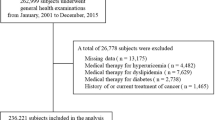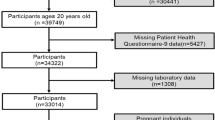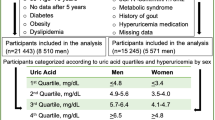Abstract
This study aimed to determine the association between serum uric acid (UA) levels and new-onset hypertension (HTN) in newly enrolled students (aged 18 to 20 years) at a university in Gifu, Japan. We analyzed data collected over a 12-year period from April 2010 to March 2022. From this dataset, we selected individuals who were normotensive at admission and underwent a follow-up examination four years later, at the time of their progression to a master’s course (n = 2859). Among these participants, 75 (2.6%) developed HTN by the second visit. Their serum UA levels (mg/dL) were significantly higher compared to those who remained HTN-free, both at baseline (6.02 ± 1.06 vs. 5.42 ± 1.17) and at the second visit (6.10 ± 1.20 vs 5.46 ± 1.22). Logistic regression analysis revealed that the odds of developing HTN were higher when considering the mean UA level across both visits (odds ratio: 1.63 per 1 mg/dL increase) compared to either the first or second visit alone. Further analysis of the relationship between elevated mean UA levels (above the cutoff value of 5.7 mg/dL) and the risk of new-onset HTN demonstrated a significant odds ratio of 3.39, which remained significant after adjusting for body mass index and sex. In summary, elevated UA levels are an independent risk factor for future HTN in young adults.

This is a preview of subscription content, access via your institution
Access options
Subscribe to this journal
Receive 12 print issues and online access
269,00 € per year
only 22,42 € per issue
Buy this article
- Purchase on SpringerLink
- Instant access to full article PDF
Prices may be subject to local taxes which are calculated during checkout

Similar content being viewed by others
Data availability
All data generated or analyzed during this study are included in this article. Further inquiries can be directed to the corresponding authors.
References
Alwan AEd. Global Status Report on Noncommunicable Diseases 2010. Geneva: World Health Organization; 2024. https://www.emro.who.int/noncommunicable-diseases/publications/global-status-report-on-ncds.html.
Hypertension. Geneva: World Health Organization; 2024. https://www.who.int/news-room/fact-sheets/detail/hypertension.
Iseki K, Ikemiya Y, Inoue T, Iseki C, Kinjo K, Takishita S. Significance of hyperuricemia as a risk factor for developing ESRD in a screened cohort. Am J Kidney Dis. 2004;44:642–50.
Obermayr RP, Temml C, Gutjahr G, Knechtelsdorfer M, Oberbauer R, Klauser-Braun R. Elevated uric acid increases the risk for kidney disease. J Am Soc Nephrol. 2008;19:2407–13.
Kawashima M, Wada K, Ohta H, Terawaki H, Aizawa Y. Association between asymptomatic hyperuricemia and new-onset chronic kidney disease in Japanese male workers: a long-term retrospective cohort study. BMC Nephrol. 2011;12:31.
Høieggen A, Alderman MH, Kjeldsen SE, Julius S, Devereux RB, De Faire U, et al. The impact of serum uric acid on cardiovascular outcomes in the LIFE study. Kidney Int. 2004;65:1041–9.
Culleton BF, Larson MG, Kannel WB, Levy D. Serum uric acid and risk for cardiovascular disease and death: the Framingham Heart Study. Ann Intern Med. 1999;131:7–13.
Johnson RJ, Sánchez-Lozada LG, Mazzali M, Feig DI, Kanbay M, Sautin YY. What are the key arguments against uric acid as a true risk factor for hypertension? Hypertension. 2013;61:948–51.
Loeffler LF, Navas-Acien A, Brady TM, Miller ER 3rd, Fadrowski JJ. Uric acid level and elevated blood pressure in US adolescents: national Health and Nutrition Examination Survey, 1999-2006. Hypertension. 2012;59:811–7.
Kuwabara M, Niwa K, Nishi Y, Mizuno A, Asano T, Masuda K, et al. Relationship between serum uric acid levels and hypertension among Japanese individuals not treated for hyperuricemia and hypertension. Hypertens Res. 2014;37:785–9.
Sundström J, Sullivan L, D’Agostino RB, Levy D, Kannel WB, Vasan RS. Relations of serum uric acid to longitudinal blood pressure tracking and hypertension incidence. Hypertension. 2005;45:28–33.
Jossa F, Farinaro E, Panico S, Krogh V, Celentano E, Galasso R, et al. Serum uric acid and hypertension: the Olivetti Heart Study. J Hum Hypertens. 1994;8:677–81.
Selby JV, Friedman GD, Quesenberry CP Jr. Precursors of essential hypertension: pulmonary function, heart rate, uric acid, serum cholesterol, and other serum chemistries. Am J Epidemiol. 1990;131:1017–27.
Kahn HA, Medalie JH, Neufeld HN, Riss E, Goldbourt U. The incidence of hypertension and associated factors: the Israel ischemic heart disease study. Am Heart J. 1972;84:171–82.
Nakanishi N, Okamoto M, Yoshida H, Matsuo Y, Suzuki K, Tatara K. Serum uric acid and risk for development of hypertension and impaired fasting glucose or type II diabetes in Japanese male office workers. Eur J Epidemiol. 2003;18:523–30.
Hunt SC, Stephenson SH, Hopkins PN, Williams RR. Predictors of an increased risk of future hypertension in Utah. A screening analysis. Hypertension. 1991;17:969–76.
Kanda Y. Investigation of the freely available easy-to-use software ‘EZR’ for medical statistics. Bone Marrow Transpl. 2013;48:452–8.
Takiue Y, Hosoyamada M, Kimura M, Saito H. The effect of female hormones upon urate transport systems in the mouse kidney. Nucleosides Nucleotides Nucleic Acids. 2011;30:113–9.
Tsushima Y, Nishizawa H, Tochino Y, Nakatsuji H, Sekimoto R, Nagao H, et al. Uric acid secretion from adipose tissue and its increase in obesity. J Biol Chem. 2013;288:27138–49.
Kahn BB, Flier JS. Obesity and insulin resistance. J Clin Invest. 2000;106:473–81.
Trayhurn P. Hypoxia and adipose tissue function and dysfunction in obesity. Physiol Rev. 2013;93:1–21.
van Baak MA. The peripheral sympathetic nervous system in human obesity. Obes Rev. 2001;2:3–14.
Kalupahana NS, Massiera F, Quignard-Boulange A, Ailhaud G, Voy BH, Wasserman DH, et al. Overproduction of angiotensinogen from adipose tissue induces adipose inflammation, glucose intolerance, and insulin resistance. Obesity. 2012;20:48–56.
Seegmiller JE, Frazier PD. Biochemical considerations of the renal damage of gout. Ann Rheum Dis. 1966;25:668–72.
Acknowledgements
The authors are grateful to the staff members involved in the study and the students at Gifu University who participated in the study. We would also like to thank Editage (www.editage.jp) for English language editing.
Author information
Authors and Affiliations
Contributions
Conceptualization: Hiroyuki Terawaki, Ryuichi Yoshimura, Mayumi Yamamoto. Formal analysis: Hiroyuki Terawaki. Investigation: Hiroyuki Terawaki. Methodology: Hiroyuki Terawaki, Ryuichi Yoshimura. Project administration: Hiroyuki Terawaki, Mayumi Yamamoto. Software: Hiroyuki Terawaki. Supervision: Takafumi Ito, Mayumi Yamamoto. Validation and visualization: Hiroyuki Terawaki. Writing – original draft and final modification: Hiroyuki Terawaki. Writing – review & editing: Ryuichi Yoshimura, Hitomi Ueda, Satoko Tajirika, Minako Kawamoto, Ryo Horita, Taku Fukao, Yasuko Ito, Takafumi Ito, Mayumi Yamamoto.
Corresponding author
Ethics declarations
Conflict of interest
The authors declare no competing interests.
Additional information
Publisher’s note Springer Nature remains neutral with regard to jurisdictional claims in published maps and institutional affiliations.
Supplementary information
Rights and permissions
Springer Nature or its licensor (e.g. a society or other partner) holds exclusive rights to this article under a publishing agreement with the author(s) or other rightsholder(s); author self-archiving of the accepted manuscript version of this article is solely governed by the terms of such publishing agreement and applicable law.
About this article
Cite this article
Terawaki, H., Yoshimura, R., Ueda, H. et al. Elevated uric acid levels as a risk factor for new-onset hypertension in newly enrolled Japanese university students (JSH46-0100). Hypertens Res 48, 780–785 (2025). https://doi.org/10.1038/s41440-024-01941-y
Received:
Revised:
Accepted:
Published:
Issue Date:
DOI: https://doi.org/10.1038/s41440-024-01941-y



